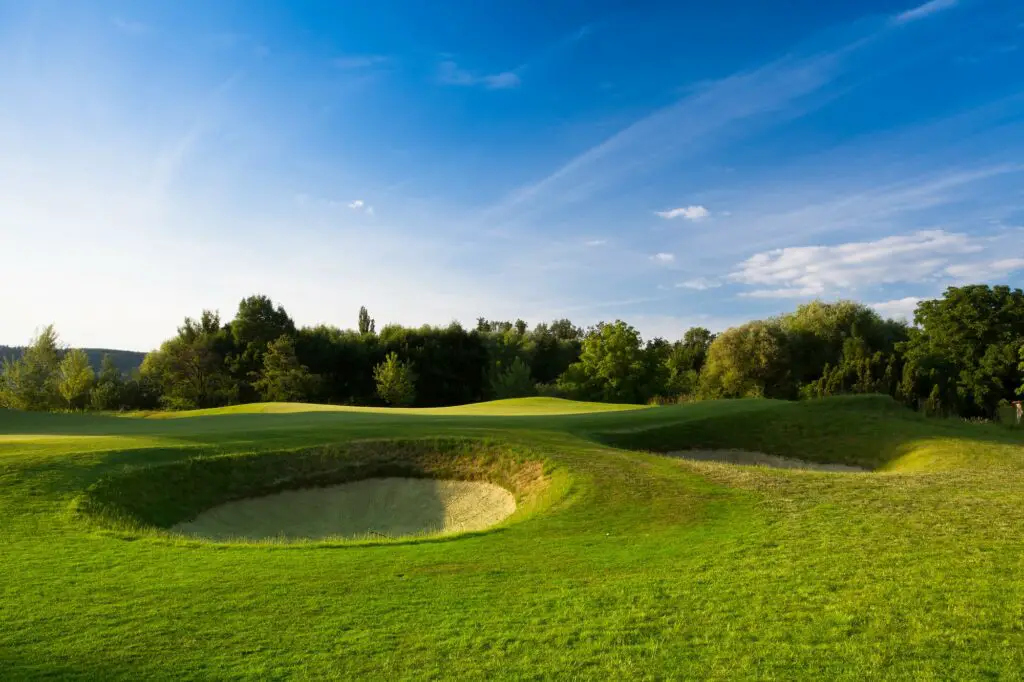Last Updated on October 16, 2023
If you’ve ever visited a golf course, you’ve most likely seen the sand traps that line the fairways – also known as ‘waste bunkers.’ In this article, I’ll explain what is a waste bunker in golf, how they’re used and the benefits of having them on the course.
Stay tuned for more information about how they’re used in play!
Definition of a Waste Bunker
A waste bunker is a type of golf hazard that typically consists of sand and is used to challenge a golfer’s skills. It is not an ordinary sand trap but rather a much deeper area where golfers must use their clubs to play a shot. The definition of a waste bunker is any area that has been specifically designed as part of the golf course to create an obstacle or challenge for golfers. Waste bunkers are often located around the fairway or green, between the tee and the putting green. They can be found on courses all over the world, but they are most common on links courses where rough terrain often makes them necessary.
Waste bunkers are also sometimes referred to simply as “wastes” or “bunkers,” depending on their size and depth. They can be either small or large, and they may even have multiple levels. In some cases, they can even be quite deep, making them difficult for players to navigate without proper technique. No matter what type of course it is, though, a waste bunker will always require careful shot selection and skilful execution to make it out alive!
Types of Waste Bunkers

Waste bunkers are an integral part of any golf course. There are five main types of waste bunkers: gravel, sand, grass, pot, and waste bunkers. Gravel bunkers are typically found around the edges of fairways and greens and can provide a challenge to golfers as they must be careful when navigating their way out of them. Sand bunkers are more common on golf courses as they provide a softer landing surface compared to gravel bunkers. Grass bunkers often contain thick grasses or weeds that can impede a golfer’s swing path and accuracy. Pot bunkers are shallow pits filled with sand that can make it difficult for golfers to hit the ball accurately from them.
Finally, waste bunkers are large sandy areas located around the perimeter of a hole that have no vegetation. Waste bunkers require players to take extra care as they often have deep ruts caused by players’ attempts to get out of them. All types of waste bunkers add an element of challenge to any golf course and should be taken into account when planning a round of golf.
Advantages and Disadvantages
Moving on from the various types of waste bunkers, let’s look at some of the advantages and disadvantages of having one on the golf course. Waste bunkers can be a great visual appeal to a golf course, adding to its aesthetic beauty. They can also help in improving accuracy by providing an obstacle to aim around or over.
However, they do have some drawbacks. One of the primary concerns is their maintenance; they require frequent upkeep and regular raking to remain playable. Additionally, if not designed correctly, waste bunkers can hinder play rather than improve it. With that being said, any well-designed waste bunker will add challenge for golfers and further enhance the overall look and feel of the course.
Safety Considerations
When it comes to waste bunkers, safety is paramount. Sand-traps can be hazardous, and accidents are not uncommon on the golf course. Risk assessment and proper safety protocols must be implemented to avoid any unnecessary injuries.
It’s important to make sure that all bunker walls are built with a uniform height and width, as well as that the sand is deep enough for players to adequately land in when their shot goes awry. When performing maintenance on bunkers, it’s also important to consider the risk of slipping or falling into the sand itself. Additionally, materials used for constructing bunker walls should be durable enough to prevent erosion over time.
Strategies for Successful Play From a Waste Bunker
When playing from a waste bunker, the key to success is having the knowledge and skills to play strategically. Utilising proper waste bunker strategies can help you ensure that your shots are successful and effective. Bunker play strategies can vary depending on the size and shape of the bunker, as well as the type of shot you want to take.

When playing out of a waste bunker, it’s important to assess the situation before making any decisions. It’s also crucial to make sure that your stance is comfortable and provides good balance. It’s important to remember that bunkers are generally filled with sand or other soft material, so taking a firmer grip on the club will help you maintain control when hitting out of them. Additionally, make sure that you open up your stance slightly in order to get better contact with the ball. Finally, try hitting slightly behind the ball to create more spin and control over where it goes.
By following these waste bunker strategies, golfers can make successful plays from bunkers every time they tee off. Knowing how to play effectively from a bunker is essential for any golfer who wants consistent success on their rounds.
Frequently Asked Questions
Is There a Difference Between a Waste Bunker and a Sand Bunker?
The primary difference between a waste bunker and a sand bunker is that waste bunkers do not have any sand in them. Waste bunkers are made up of native soil which consists of grass, dirt, rocks and other natural materials. This type of hazard requires more maintenance as it is prone to erosion and can be harder to keep in good condition. Sand bunkers on the other hand, are much easier to maintain and can provide a smoother playing surface for golfers when they hit their shots out of the hazard.
In order to keep your course looking its best, there are several things you should consider:
Building Cost:
- Waste Bunkers: More expensive due to additional support structure needed for soil composition
- Sand Bunkers: Cheaper than waste bunkers but still require regular maintenance
Maintenance Best Practices:
- Waste Bunkers: Need more frequent upkeep due to erosion potential from natural elements like wind and rain
- Sand Bunkers: Easier to maintain overall with less frequent maintenance
With proper knowledge and understanding of both types of hazards, you can ensure that your golf course looks its best for years to come.
What Are the Rules for Playing From a Waste Bunker?
First and foremost, it’s important to know that playing from a waste bunker is usually considered to be a hazard, meaning that you’re not allowed to ground your club when making your shot. This means that if you hit the ball while it’s still in the bunker, you’ll incur a penalty stroke. Additionally, you can’t touch or move any loose impediments while in the bunker – this includes stones or sand clumps – and you’re also not allowed to rake the area after your shot.
It’s worth noting that any water runoff that collects in a waste bunker does not count as part of it; therefore, players are generally allowed to move their balls out of these areas without taking a penalty stroke. In this case, however, players must ensure they replace their ball where it had originally been before hitting their shot. All in all, being aware of these specific rules for playing from a waste bunker will help reduce any penalties incurred during a round of golf and make for an enjoyable experience overall.
Conclusion
So. what is a waste bunker in golf? Having a waste bunker on the golf course is an important part of the game. Not only does it help to keep the course looking great, but it also provides golfers with an advantage when playing certain shots. Building and maintaining a waste bunker can be costly, but with proper planning and maintenance, you can ensure that your waste bunker will last for years.



